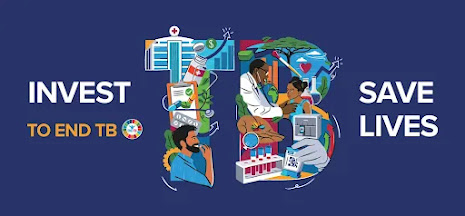FORUM ‘Invest to End TB. Save Lives.’World TB Day 2022
The theme of World Tuberculosis Day 2022 - ‘Invest to End TB. Save Lives.’ –conveys the urgent need to invest resources to ramp up the fight against TB and achieve the commitments to end TB made by global leaders.
KEY MESSAGES
Urgent investment of resources, support, care and information are vital to win the fight against TB.
Essential TB services should be sustained during the COVID-19 pandemic to ensure that gains made in the fight against TB are not reversed.
Tackling health inequities to ensure health for all.
Ending TB requires concerted action by all sectors
• 226 000 children and adolescents lost their lives from this preventable and curable disease in 2020.
• 21 000 (or 9%) of the children and young adolescents under 15 years who died of TB were living with HIV.
• In 2020, an estimated 63 % of children and young adolescents below 15 years with TB were not reported or didn’t get access to lifesaving TB diagnosis and treatment services; the proportion was even higher - 72% - for children under 5.
• Progress towards reaching the targets set at the UN High Level Meeting is lagging behind:
- Approximately 1.4 million children were diagnosed and notified between 2018 and 2020, which is only 41% of the 2022 target of 3.5 million.
- Only 12 200 children started treatment for MDR/RR TB in that period, which translates to less than 11% of the 2022 target.
- Only 29% of eligible children under 5 years accessed TB preventive treatment between 2018 and 2020. Almost two thirds of eligible children under 5 years therefore remain at risk of getting sick with TB.
IMPORTANCE OF ADDRESSING
TB IN CHILDREN AND
ADOLESCENTS
Diagnosing TB in children can be challenging
due to many factors, including the nonspecific nature of TB symptoms that are similar
to other childhood illnesses and difficulties in
collecting specimens for diagnostic testing.
Infants and young children (especially those
under two years) are at higher risk of
developing TB meningitis and disseminated
disease, which are associated with high
morbidity and mortality.
Adolescents usually present with infectious TBdisease, as typically seen in adults. However,
adolescents also form a particularly
vulnerable group who face psycho-social
challenges, requiring careful consideration of
their growing autonomy, treatment support
and assistance with transitioning from
paediatric to adult health service provision.
We need to manage TB in children and
adolescents recognising the unique
characteristics and needs of these groups, as
well as those of their parents, caregivers and
families.
IMPACT OF THE COVID-19 PANDEMIC
• COVID-19 has had an additional negative and disproportionate impact on children
and adolescents with TB and at risk of TB.
• There has been a steady increase in notifications of children with TB from just over
340,000 in 2011/2012 to over 520,000 in 2019, with a substantial drop in 2020, as a result
of the impact of the COVID-19 pandemic.
• A detailed analysis shows that TB notifications in children aged below 5 years dropped
by 28% between 2019 and 2020 due to COVID-19 disruptions, these figures for children
aged 5-14 years and for those aged 15 years and above were 21% and 18%.
• Overall deaths increased for the first time in a decade to 1.5 million up from 1.4 million
in 2019, as a result of the impact of the COVID-19 pandemic.
• The 2022 WHO Consolidated Guidelines and Operational Handbook on the
management of tuberculosis in children and adolescents include recommendations
that span the TB cascade of care, from screening, prevention and diagnostic
approaches to treatment of both drug susceptible and drug resistant TB, to models
of care to optimize TB prevention and case detection efforts.
The new
recommendations recognize the impact of COVID-19 on TB services and the need
to find more children and adolescents with TB.
WHO, UNICEF, Stop TB Partnership and other
partners released an action plan in 2018
outlining measures to prevent and treat TB in
children and adolescents.
The roadmap
highlights key actions
to end TB in children
and adolescents, such
as high level leadership
& accountability,
functional partnerships,
increased funding,
advocacy, integrated
family- and
community-centred
strategies, improved
monitoring, and more
child and adolescent
TB research.
EVENTS :
The event will take place in a talk-show format with speakers connected by video on WHO’s interactive web-platform- End TB Forum. The main speakers will include Ministers, leaders and other high-level government representatives, Heads of Agencies, TB survivors, civil society and partners. The Show will be broadcast live, with interactive Q&A from the audience online.





No comments:
Post a Comment